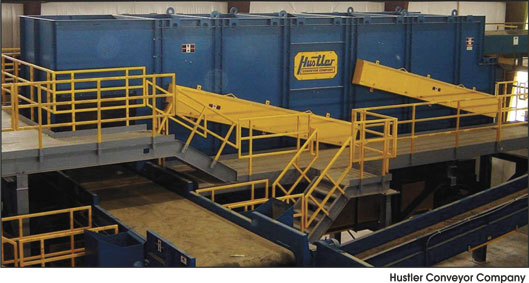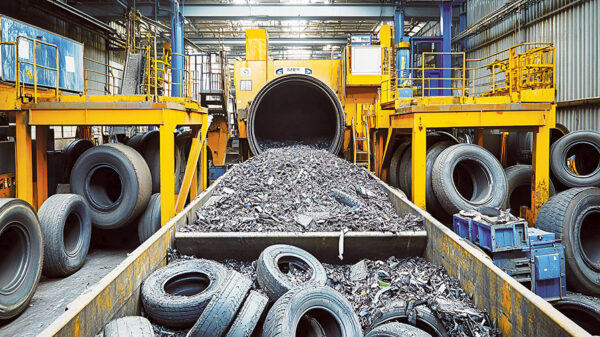MANUFACTURERSAction Equipment Company, Inc. Andritz AG DeHart Recycling Equipment Inc Green Machine Sales LLC hamos GmbH Recycling- und Hustler Conveyor Company MSS Optical Sorting Equipment Redwave Solutions US LLC Sherbrooke OEM, Ltd. Tomra Recycling Tuffman Equipment ZenRobotics Oy |
It more important than ever to divert as much waste from landfills as possible and it must be done efficiently. Equipment options for sorting items culled from the waste stream vary and the vendors noted in this article are happy to assist in choosing the best products for your operation.
A leader in the vibratory equipment sector since its inception in 1972, Action Equipment Company is dedicated to the design, manufacture and installation of vibratory equipment for the efficient processing of bulk materials.
A key product for sorting is the Dense-Out® vibratory air separator, a rugged vibratory air knife. The conveyor uses air to separate “heavies” from “lights” when processing items such as plastic and paper from glass. The unit can be configured with single or multiple air knives, depending on the level of separation required. An optional Dense-Out addition adds a Taper-Slot® rugged, finger screen at the unit in-feed, which sorts fines from the stream. This product is popular in settings such as construction and demolition (C&D) recycling, glass cleaning, aggregate cleaning, removing rocks from biomass/hog fuel and auto shredder residue clean up.
“From day one, Action has been innovative in bringing vibratory equipment to the next level. Our commitment is to never settle and bring better solutions to a technology that has been around for decades,” president Andrew LaVeine stated. The firm’s newest product is the Sub-Pan Free™ Dense-Out/Taper-Slot screen, which eliminates the sub pan under the screens. This product eliminates one additional, large surface area which could attract wet and sticky material. Instead, screened materials drop directly into a bunker or onto a takeaway conveyor. For many customers that handle problematic materials, this option reduces maintenance and cleaning time.
 Jarrod McKay, Hustler Conveyor sales associate, explained that, “Our OCC screens and systems provide a solution for an immediate and long-term need, amidst the worldwide COVID-19 pandemic. Waste recycling facilities are upgrading and adding to their systems to handle the significant increase in OCC output. Consumer use consistently pushes OCC consumption to record levels as quarantines, social distancing protocols, and stay-at-home orders are the new normal. Meanwhile, our online orders have increased dramatically. This rise in online deliveries is directly responsible for the current influx of OCC processed on the tipping floor today. Although online sales can be expected to decrease eventually, this crisis has forced late majority and laggard consumers to utilize technologies and services which now maintain the overall increase of OCC output for the indefinite future.”
Jarrod McKay, Hustler Conveyor sales associate, explained that, “Our OCC screens and systems provide a solution for an immediate and long-term need, amidst the worldwide COVID-19 pandemic. Waste recycling facilities are upgrading and adding to their systems to handle the significant increase in OCC output. Consumer use consistently pushes OCC consumption to record levels as quarantines, social distancing protocols, and stay-at-home orders are the new normal. Meanwhile, our online orders have increased dramatically. This rise in online deliveries is directly responsible for the current influx of OCC processed on the tipping floor today. Although online sales can be expected to decrease eventually, this crisis has forced late majority and laggard consumers to utilize technologies and services which now maintain the overall increase of OCC output for the indefinite future.”
How do facilities adapt to this surge in consumer purchasing practices? “Facilities which need to process more tonnage are considering the addition of new processing locations, additional lines for existing systems, or the retrofit of new/upgraded higher throughput machines. With over 50 years serving the recycling industry, Hustler Conveyor continues to design, engineer, and manufacture full systems, incorporating our Heavy-Duty Double Deck OCC separating screens, which process up to 20 tons of material per hour. Our triple deck unit is incorporated into systems that are required to process tonnages up to 30 tons per hour. Each machine deck is composed of 26” abrasion resistant steel discs and each deck has dedicated drives for independent speed control to improve separation of varying materials. Interfacing chutes, supports, and platform structures are custom designed and fabricated to customer specifications,” McKay noted.
 Redwave has designed and built systems to handle every main landfill diversion strategy; refuse derived fuel (RDF) production, recycling of high value materials from the household waste stream, and composting systems for organic waste management. “For RDF production, we have developed full mechanical and biological waste treatment facilities that transform household and commercial waste into fuel for powering waste-to-energy plants. This is achieved by increasing the Btu value of this fuel source. Redwave has completed projects in operations around the globe that range from input capacities of 105,000 metric tons per year to 650,000 metric tons per year. With the leading Redwave sensor sorting machines based on camera, NIR and XRF technologies, recyclers can recover valuable resources during processing and remove materials that are detrimental to the waste-to-energy process, like vinyl based materials. Our biological treatment systems are also used for composting facilities. At Redwave, we believe it’s not waste, it’s value,” said Parker Pruett, sales manager.
Redwave has designed and built systems to handle every main landfill diversion strategy; refuse derived fuel (RDF) production, recycling of high value materials from the household waste stream, and composting systems for organic waste management. “For RDF production, we have developed full mechanical and biological waste treatment facilities that transform household and commercial waste into fuel for powering waste-to-energy plants. This is achieved by increasing the Btu value of this fuel source. Redwave has completed projects in operations around the globe that range from input capacities of 105,000 metric tons per year to 650,000 metric tons per year. With the leading Redwave sensor sorting machines based on camera, NIR and XRF technologies, recyclers can recover valuable resources during processing and remove materials that are detrimental to the waste-to-energy process, like vinyl based materials. Our biological treatment systems are also used for composting facilities. At Redwave, we believe it’s not waste, it’s value,” said Parker Pruett, sales manager.
Pruett added, “Overall, the amount of materials that have been diverted from landfills in the U.S. since 1990 has increased from 43 percent to 48 percent of the total MSW. Composting volume has doubled and recycling volume has increased by 20 percent. Redwave’s ability to create turnkey sorting systems provides tremendous value to recyclers all over the world. Using our unmatched technology, clients minimize disposal costs and create revenue streams for high purity sorted raw materials like paper, plastics, glass and nonferrous metals. Specific to RDF production, initiatives like California’s recent passage of SB 100, which mandates 60 percent of that state’s energy to come from renewable sources by 2030 and 100 percent by 2045, drives increased interest in this technology.”
Redwave Solutions US is the North American division of BT-Wolfgang Binder GmbH, an international plant design/build firm with a proprietary line of sensor sorting equipment for the recycling industry under the Redwave trademark. Over the past 20 years, the company has become a world leader in several segments of the recycling industry.
Published in the September 2020 Edition








